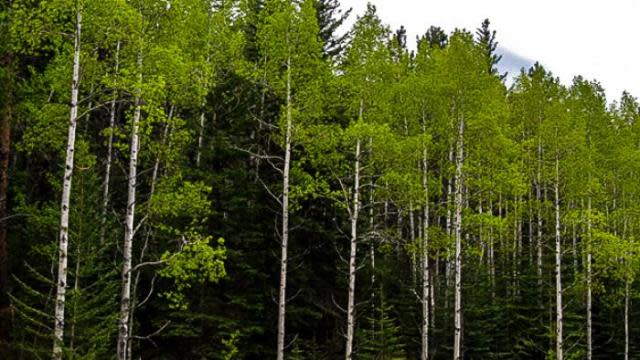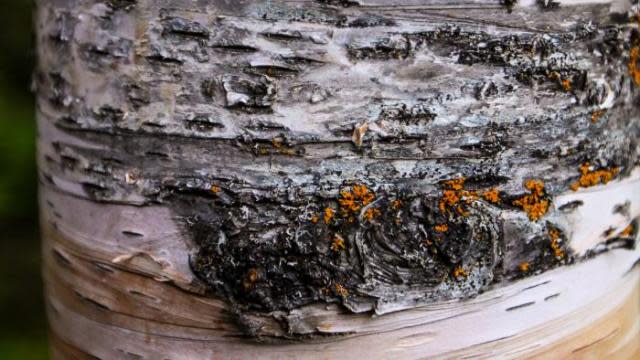
Aspen & Birch
Contrasting the forest green of the ponderosa pines are vibrant green foliage and stark white bark of the Aspen and Birch trees. Abundant throughout the Black Hills, these two trees are commonly interchanged due to their similar appearances. Slender in size and clothed in white bark, they are both deciduous – meaning they lose their leaves each fall.

Aspen Trees
Coined “quaking aspen”, the leaves of an Aspen tree tremble with the slightest breeze. As you hike along a trail, take notice of the slight breeze and the way the leaves tremble. In the fall, the sunlight shimmers off the golden, fluttering leaves for a serene moment of beauty, and one that the Lakota culture believed was a connection to the spiritual world. Aspen trees share a root system that can last thousands of years, and you will often find a large grove of aspen growing alongside one another. The life span of an aspen is typically 100 to 200 years.
Birch Trees
Birch trees, similar in appearance to aspen, typically live 80 years and may be spotted as a singular tree or a larger grouping, as they grow as seeds rather than an extensive root system. In many native populations the birch represents purity and protection. The trees also are said to ward off evil spirits and negative energy.
Bare Bark
Similar in size, aspen and birch trees typically grow to about 80 feet tall with a trunk nearly 3 feet in diameter. Both have a distinct, smooth white bark; however aspen bark has a distinct green tint and is marked with black horizontal scars and black knots. The birch tree is marked with horizontal scars, as well, but does not have the black knots that resemble an eye.
Birch bark also has a flakey layer on the trunk that easily peels off into paper curls, while aspen bark hangs tight to the tree.
Foliage
From leaves that change from vibrant green in the summer to golden yellows in the fall, these beauties offer a pop of color and contrast to the landscape of the Black Hills. However, the trees’ foliage provides more differentiation between the two species. Aspen leaves resemble a heart-shape, while birch foliage is more oval with tapering tips.
Uses
Both trees were used medicinally by Native Americans. Bark and leaves from both trees were used to make tea and bandages that aided with things like fevers, pain, and inflammation. Birch wood is strong, flexible, and waterproof, and was used to make tools and build canoes. Aspen trees attracted wildlife like deer, elk, and birds for the Lakota to hunt.
Today, aspen trees are used to make paper and boxes, while birch trees are still used to build canoes and interior trim because of its waterproof qualities.
Both trees create tube-shaped flower clusters called catkins, which are pollinated by the wind. The difference between the flowers of each tree is the birch tree can produce male and female flowers, which allows the tree to become easily pollinated. Even though most new birch trees grow from seed, they can regenerate via sprouts if cut down or burned.
As you stop along scenic routes in the Black Hills or lace up to hit the trails, take a moment to listen for the rustle of quivering aspen and run a hand along the smooth bark of a birch tree, enjoying their energy and beauty amongst the Black Hills.
For a full list of stunning day hike’s visit: Black Hills National Forest - Hiking:Day Hiking
Bradley Block, with the National Forest Services notes that Big Hill Trails in the Northern Black Hills is one of the best locations for observing aspen trees. Hikers flock to the trails year-round, but the summer and fall are some of the best months to observe vibrant coloring of the aspen trees. Another popular route is the ’76 Trail in Spearfish Canyon. Much of the trail is surrounded by aspen and birch trees. In the Southern Hills, Iron Creek Trail in the Hell Canyon Ranger District is a prime spot to wander across creek crossings and immerse yourself in aspen and birch galore.
